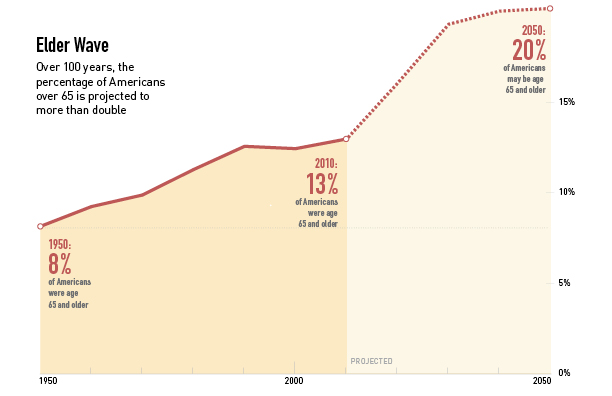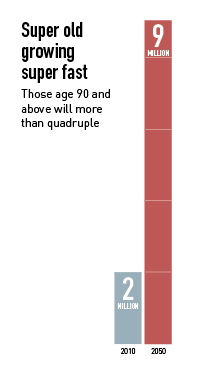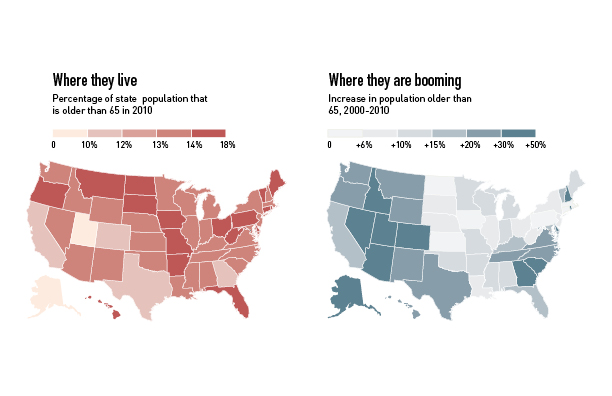Every day 10,000 more Americans turn 65. The baby boomers are behind an unprecedented agequake that will shake up not only this country, but the rest of the developed world. How will this vast new market impact the economic and social landscape? What are the opportunities for business to interface and innovate with these new, mature, sophisticated audiences?
This is the first article in a series, "Infinia on Aging," that explores how the experience of aging is being reshaped - and how it is reshaping consumer demand and behavior domestically and globally.
* * * *
In the bustling South Waterfront section of Portland, Oregon, looms the oddest of retirement communities. The $130 million Mirabella Towers offers 240 units and a lifestyle that is a far departure from the dull notion of getting put out to pasture.
The Mirabella sits amid a bustling urban district of restaurants and parks rising on former industrial wasteland near downtown Portland. The building is a landmark in energy efficiency, cutting-edge technology, and convenience for boomers wanting a more active lifestyle in their old age. "Historically, upscale senior housing has been a rural three-story entity spread over 30 acres" one of the building's architects told the New York Times. "This is a 30-story building on one acre with a streetcar stop at the front door."
The Mirabella is at the forefront of fast changes coming to the nation and its elderly. More than just a marketing ploy, the building's compact and sophisticated approach is the sort of creative response needed to weather a transformation that is enveloping the nation: America is rapidly aging.

The country faces an age shift that is undeniable, unstoppable and unprecedented. Sometimes called a "silver tsunami," the country's elderly will surge in numbers over the coming decades to become a dominant part of the population. Naysayers see the change as a looming threat to our way of life, where the retired become an unbearable burden on the working.
Many recognize opportunity amid the turmoil.
Whatever the view, the projections are startling. The number of Americans 65 and older will more than double between 2010 and 2050, to 87 million.
 This projection gives rise to understandable anxiety. U.S. policymakers face tough challenges in financing the retirement of the baby boomers, the oldest of whom began turning 65 last year. Sometimes called golden boomers as they move into retirement, the "me" generation that was known for its self-absorption has hardly put away enough gold to pay its own way. The typical boomer has saved less and is in worse health than were their parents as they approached retirement, argue the authors of a 2007 book, Baby Boomers and Their Parents.
This projection gives rise to understandable anxiety. U.S. policymakers face tough challenges in financing the retirement of the baby boomers, the oldest of whom began turning 65 last year. Sometimes called golden boomers as they move into retirement, the "me" generation that was known for its self-absorption has hardly put away enough gold to pay its own way. The typical boomer has saved less and is in worse health than were their parents as they approached retirement, argue the authors of a 2007 book, Baby Boomers and Their Parents.
Yet their sheer numbers threaten to overwhelm a Social Security and Medicare system designed to support retirees with contributions from current workers. Policymakers face tough choices between cutting benefits to the older generation or raising taxes on the younger. Many books warn that such conflict over limited resources is a natural product of an aging world. Projections that world population will reach 9 billion in 2050, and that more of those people will be living into their 80s and 90s, mean that people at midcentury will have lived about 500 billion more years than they would have had they been born in 1900, writes journalist Ted Fishman in his 2010 book, Shock of Gray.
Alarms about such a seismic change are sounding across the developed world, whose riches are feared inadequate to withstand the upheaval that is coming. 
"No other force is likely to shape the future of national economic health, public finances, and policymaking as the irreversible rate at which the world's population is aging," Standard & Poor's wrote in a broad report in 2010 that borrows its title from Al Gore's gloomy book about climate change, Global Aging 2010: An Irreversible Truth.
The agency warns that finances will deteriorate almost universally across advanced economies. Assuming no policy changes, deficits will rise, slowly at first and then accelerate. Countries need to act this decade, S&P says, before the pressures rise-both from the cost of benefits and the number of elderly who would be defending them.
What may happen, according to the Center for Strategic and International Studies, is that power will transition to countries with growing populations, while manpower shortages will tempt some developed countries to abandon their militaries altogether. Borders will become more porous as the poor from growing and less-developed countries are drawn to unfilled jobs in wealthier countries. In short, "The 2020s promise to be a decade in which breaking population trends come to play an important role in world affairs," say CSIS analysts.
But there are those who argue against the doom and gloom. Aging will prove a net positive for the world, argues social scientist Theodore Roszak in his 2009 book, The Making of an Elder Culture. For one, aging in America is not a product of the Baby Boom moving into retirement. The nation began growing older decades ago and will continue to grow older after the boomer bulge has moved through the python. "Since the late 19th century, aging has been the normal state of all industrial societies," he wrote. "It is a sustained trend."
It is not a bad trend, either, Roszak argued. The boomer generation, for one, has the opportunity to reshape how older Americans are viewed. The society can develop a new respect for their elders that was lost in the fascination with youth that rode along with boomers when they were young.
His theme is echoed in the view of environmentalist Fred Pearce, who wrote of the potential benefits of an aging society in a 2010 op-ed for the Washington Post. Yes, we may need to work longer, at least beyond the artificial cutoff of 65, but "age brings experience and wisdom," he wrote. "The older we are, the less likely we are to be hooked on the latest gizmos and the more we should appreciate things that last. We may even reduce pressure on the world's resources by consuming less and by conserving our environment more."
Even the button-down magazine The Economist joined the herd in reporting on what has become an undeniably timely issue, featuring a 2010 cover article heralding aging as a good thing, noting "although as people move towards old age they lose things they treasure-vitality, mental sharpness and looks-they also gain what people spend their lives pursuing: happiness." And happiness promotes productivity, The Economist said.
So our growing older may or may not prove a bad thing. But it clearly will generate turmoil, and from the churn will emerge opportunity. That's what the builders of the Mirabella saw.
* * * *
Ron Cappello is founder and CEO of the strategic branding and design firm, Infinia.